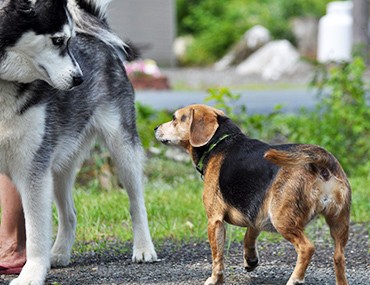Social skills are just as important for your canine pal as they are for each of us. A well-mannered, well-adjusted dog who can adapt to a variety of situations with new people and other pets will be a happier dog and a better companion for you.
What defines a well-socialized dog?
Dogs that are comfortable meeting and being around a variety of people of all ages, other dogs, and even other types of pets – especially cats – are considered well socialized. Being relaxed and receptive to new people and pets isn’t something that comes naturally to every dog, any more than it does to every person. Some dogs are extroverts and others are timid. Some dogs are naturally comfortable with people, but take a bit more time getting used to another dog or cat.  Why is socializing a dog important?
Why is socializing a dog important?
If you socialize your dog in a variety of situations, especially those situations in which you often find yourself (households with lots of children or pets, dog parks with your other dogs, a busy city street, etc.), you’ll know how he is going to react and feel confident that your dog is going to be comfortable and well behaved in any situation.
If you’re not focusing on social skills from an early age, you’re basically always putting your dog into new and surprising situations. This can lead to fear, insecurity, and the negative behaviors that come with those emotions.
The Social Puppy Top 4 Tips
1. Start early. When your veterinarian gives you the go-ahead, make routine “social engagements” part of his life. These can be as simple as meeting neighbors or other neighborhood pets as you take walks. You can also find local playgroups or doggie daycare facilities (in the case of a puppy, be sure they have classes specializing in younger dogs–you don’t want a little tyke to be thrown in with the big dogs right away). Dog parks can also be a good possibility, but these require a bit more thought and research and aren’t a place for very young dogs; see our article on dog parks for more information. Also, always make sure that your dog is up to date on vaccines and preventatives that protect against parasites such as fleas and intestinal worms.
2. Mix it up. Make sure that you introduce your dog to a variety of situations. A dog who only meets puppies might not be at all comfortable the first time he bumps into an adult. Even spending time only with dogs of a particular gender, breed, or size can limit your dog’s comfort with future introductions to different dogs. If you think about it, the same applies to people. A dog that’s totally comfortable with adults can be completely freaked out by the well-intentioned toddler who comes running his way. Children have a very different kind of energy than adults and many dogs are very sensitive to that. It’s worth giving your dog some extra attention.
3. Be part of the social experience and pay attention to your dog’s reactions. Don’t just introduce your dog to his new human or animals friends and let him figure things out on his own, especially when he’s young or new to your household. Stay with your pet, observe his comfort level, and assess whether he’s happy, nervous, anxious, fearful, or crabby. If he’s having a positive reaction, provide lots of praise and encouragement. If he’s not as comfortable, make introductions to these situations brief, still provide encouragement when he engages positively and remove him from the situation if he exhibits a negative or fearful behavior using a verbal correction if necessary (no, don’t jump, down, etc.).
4. Accept your dog’s preferences and limitations. Some dogs are never going to love kids; however, every dog should be well mannered around kids. In this case, you want to understand that your dog is never going to be the dog who is in the back yard playing with your nieces and nephews, but he can be the dog who’ll be calm and trustworthy around kids, even if it requires some extra effort and training. Likewise, not every dog will want to play with other dogs. But you want to know that you can comfortably walk your dog on the street and he’ll be calm when passing another dog during your strolls. Sometimes, you might need help from a professional trainer to get your dog comfortable in these situations. Talk to your veterinarian for tons of tips and tricks.
The important thing to remember is that you want your dog’s world to be a happy and comfortable place. That doesn’t mean his life is free from anxiety any more than ours is. It does mean you can help your dog be prepared for a variety of situations, be confident regardless of what comes his way, and simply know when your dog is going to be the social butterfly and when your dog will be the wallflower!
If you have any questions or concerns, you should always visit or call your veterinarian – they are your best resource to ensure the health and well-being of your pets.
